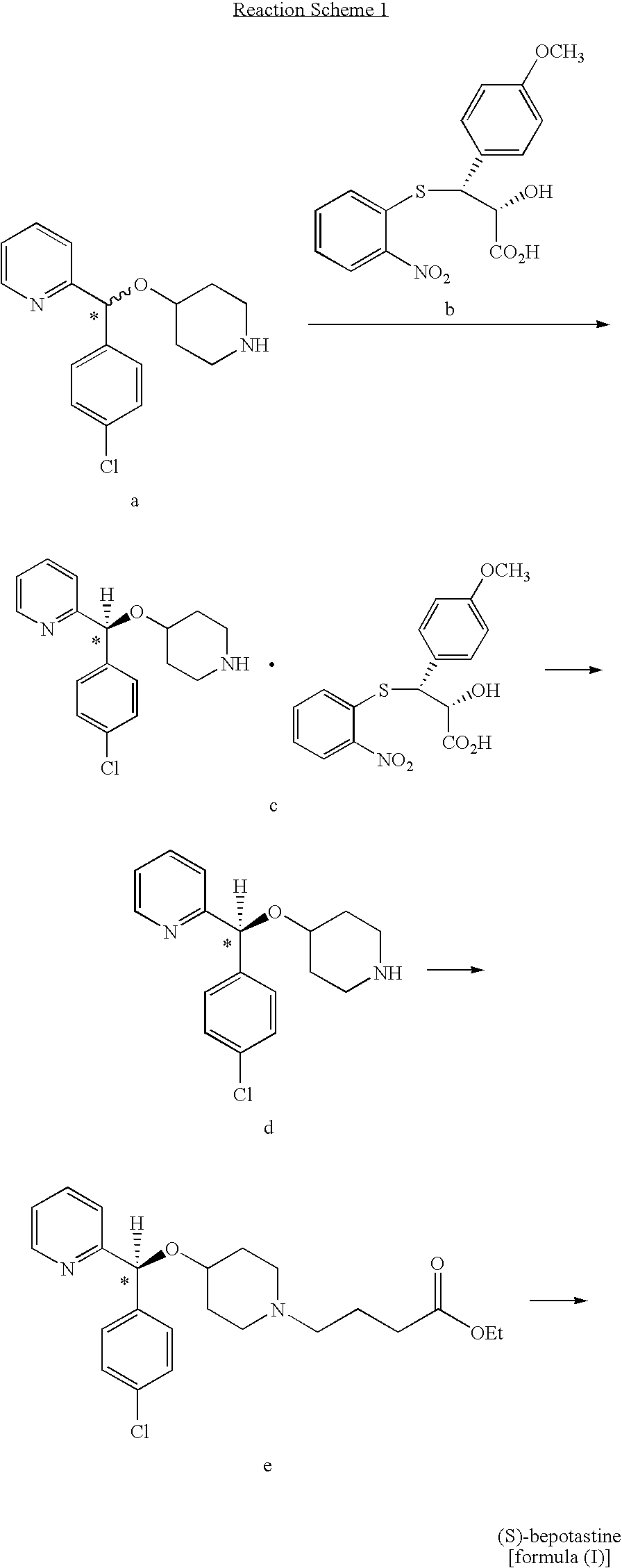Process for preparing bepotastine and intermediates used therein
a technology applied in the field of stereospecific preparation of bepotastine and intermediates used therein, can solve the problems of complex above-mentioned methods, economic disadvantages, and ineffective racemization requiring high temperature in butanol in the presence of bas
- Summary
- Abstract
- Description
- Claims
- Application Information
AI Technical Summary
Benefits of technology
Problems solved by technology
Method used
Image
Examples
example 1
Preparation of racemic (RS)-bepotastine l-menthyl ester (the compound of formula (II))
[0050]24.0 g of (RS)-4-[(4-chlorophenyl)(2-pyridyl)methoxy]piperidine was dissolved in 240 ml of acetone, 27.0 g of 4-bromobutanoic acid l-menthyl ester obtained in Preparative Example 1 and 18.3 g of K2CO3 were sequentially added thereto, and the resulting mixture was refluxed for 7 hours. The reaction mixture was filtrated to remove insoluble solids, and the solvent was removed from the filtrate under a reduced pressure, to obtain 42.0 g (99%) of the title compound as an oil.
[0051]1H-NMR (DMSO-d6, ppm): δ 8.5 (m, 1H), 7.7 (t, 1H), 7.5 (d, 1H), 7.4 (d, 2H), 7.3 (m, 2H), 7.2 (m, 1H), 5.6 (s, 1H), 4.7 (m, 1H), 3.5 (br. s, 1H), 2.7 (m, 2H), 2.3 (m, 4H), 2.1 (m, 1H), 2.0-1.6 (m, 11H), 1.5 (m, 1H), 1.4 (m, 1H), 1.2 (m, 3H), 0.9 (d, 6H), 0.7 (d, 3H).
[0052]IR (KBr, cm−1): 2952, 2869, 2810, 1727, 1588, 1489, 1468, 1455, 1370, 1187, 1086, 984, 807, 768, 749.
example 2
Preparation of racemic (RS)-bepotastine l-menthyl ester (the compound of formula (II))
[0053]1.0 g of 4-chlorobutanoic acid l-menthyl ester obtained in Preparative Example 2 and 1.25 g of sodium iodide were added to 10 ml of methyl isobutyl ketone, and the mixture was refluxed for 5 hours. To the resulting mixture, 1.0 g of (RS)-4-[(4-chlorophenyl)(2-pyridyl)methoxy]piperidine and 1.7 g of potassium carbonate were sequentially added, followed by refluxing for 1 hour. Then, 15 ml of water and 30 ml of ethyl acetate were added to the reaction mixture to carry out extraction. The organic layer was separated therefrom, and concentrated under a reduced pressure, to obtain 1.8 g (99%) of the title compound as an oil.
example 3
Preparation of bepotastine l-menthyl ester.N-benzyloxycarbonyl L-aspartate (the compound of formula (III))
[0054]90 g of (RS)-bepotastine l-menthyl ester obtained in Example 1 was dissolved in 900 ml of ethyl acetate, 45.7 g of N-benzyloxycarbonyl L-aspartic acid was added thereto, and the resulting mixture was stirred at room temperature for 12 hours. The solid precipitates formed therein was filtered and dried to obtain 48.2 g (yield: 71%, optical purity: 89.7%) of the title compound as a white crystal.
[0055]45.0 g of the compound thus obtained was added to 450 ml of ethyl acetate, and the resulting mixture was fully dissolved by heating. The solution was slowly cooled to room temperature and stirred for 12 hours to induce solid precipitation. The solid was filtered and dried, to obtain 39.2 g (yield: 87%, optical purity: 96.7%) of the title compound as a white crystal.
[0056]36.0 g of the crude product thus obtained was recrystallized from ethyl acetate by repeating the above proce...
PUM
| Property | Measurement | Unit |
|---|---|---|
| temperature | aaaaa | aaaaa |
| temperature | aaaaa | aaaaa |
| pH | aaaaa | aaaaa |
Abstract
Description
Claims
Application Information
 Login to View More
Login to View More - R&D
- Intellectual Property
- Life Sciences
- Materials
- Tech Scout
- Unparalleled Data Quality
- Higher Quality Content
- 60% Fewer Hallucinations
Browse by: Latest US Patents, China's latest patents, Technical Efficacy Thesaurus, Application Domain, Technology Topic, Popular Technical Reports.
© 2025 PatSnap. All rights reserved.Legal|Privacy policy|Modern Slavery Act Transparency Statement|Sitemap|About US| Contact US: help@patsnap.com



